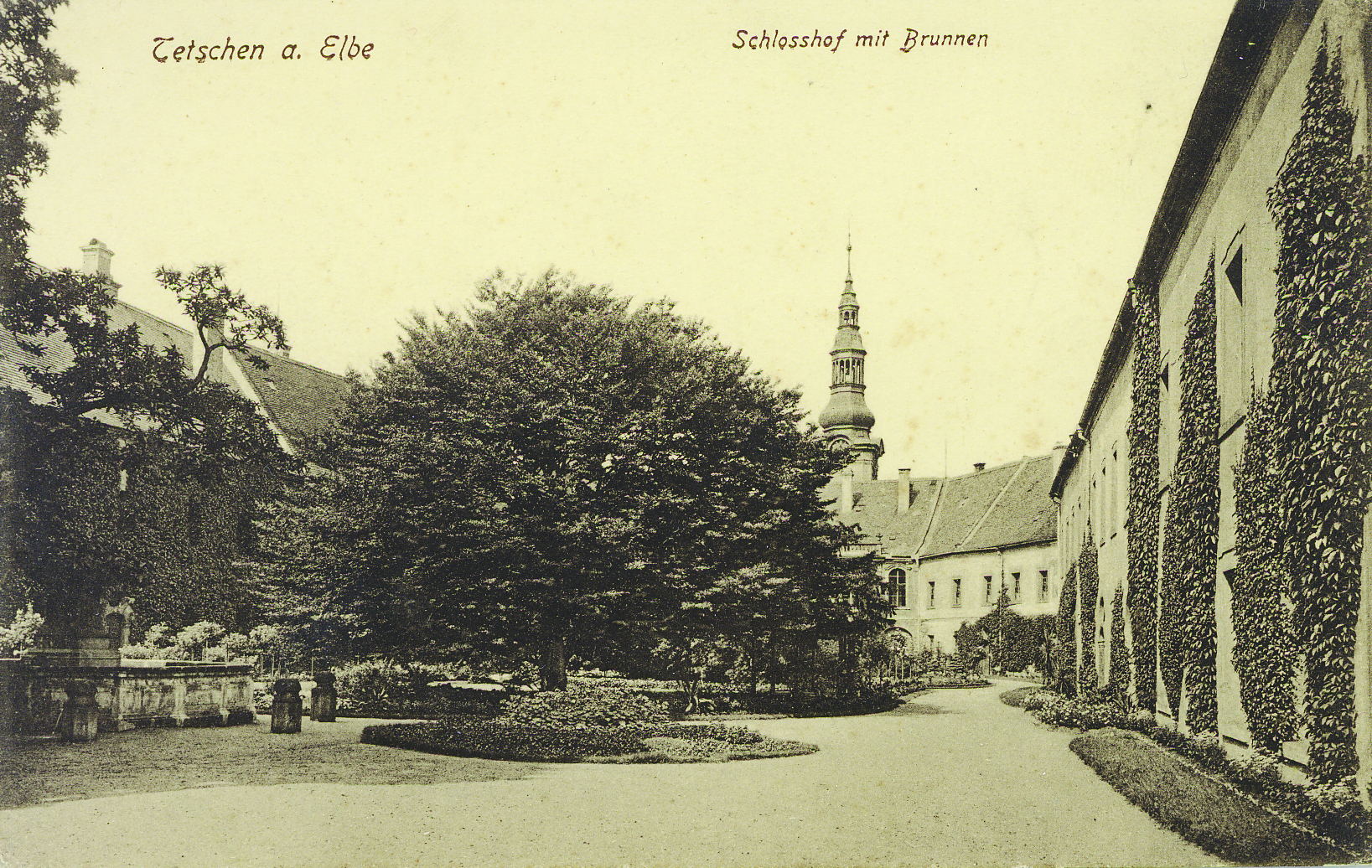Zámek Děčín>Info>About the castle> Castle History
Castle History
The forerunner of the Děčín Castle was a wooden fortress built towards the end of the 10th century by the Bohemian princes controlling the surrounding Děčín province. The first written record of the province dates from 993 A.D. and of the fortress itself from 1128. In the thirteenth century this original wooden structure was rebuilt in stone as a royal castle that, under unknown circumstances, fell into the hands of the powerful Wartenberg dynasty around 1305.
No one knows exactly how this medieval castle looked. However, we can say with some certainty that it was divided into two sections – the upper (rear) and lower (forward) parts, which each operated more or less independently. This layout endured until the end of the 18th century, and even survived siege and fire in 1444. Numerous later renovations, however, erased all but fragments of the original medieval semblance of the castle. A significant change to the castle came in the second half of the 16th century when it was held by the Saxon Knights of Bünau, who gradually rebuilt the lower castle into a Renaissance palace with a grand ceremonial hall. Rudolph of Bünau had the walls adorned with life-size portraits of 22 members of the Bünau clan. Remodeling at the end of the eighteenth century destroyed these murals. Fortunately, their likenesses, commissioned in 1775, were recently discovered in the collections of the National Museum in Prague.
The current semblance of the castle is the work of the Thun-Hohensteins, who held the Děčín lands from 1628 to 1932. The Thuns originally came from southern Tyrol and gradually worked their way to the upper echelons of Hapsburg society where they regularly filled important political and church appointments. For example, Leo von Thun-Hohenstein served as Minister of Religion and Education in the 19th century and his nephew Franz twice held the function of Bohemian Vice-Regent (1889–1896 and 1911–1915) and was even Minister-President of the Austrian government and its Interior Minister. For his service he was given the hereditary title of Prince in 1911 to be passed to every first-born son.
The Thuns reworked the castle twice. The first reconstruction, in the Baroque style, was undertaken by Maximilian von Thun, Imperial envoy and diplomat, and was meant to enhance the ceremonial aspects of the property. A central element of the project was a grand access road, the Long Drive, ending in the upper gate of the completely rebuilt entry wing. Along the drive stretched an ornamental garden (today known as the Rose Garden) and a riding yard. Maximilian’s brother Johann Ernst von Thun was responsible for the erection of the Church of the Ascension of the Holy Cross in the town below. The architect is unknown.
The second and final reconstruction of the castle was undertaken in 1786–1803. It was entrusted to the Děčín architect Josef Václav Kosch, who chose to unify the diverse elements of the castle organism and give the whole complex a harmonious appearance. To do so he had the Gothic and Renaissance palaces torn down, leveled all structures to the same height and gave them a unified facade. On the riverfront the castle's new dominant feature arose, a slender clock tower. Thus the castle took on the Baroque-Classical style we see today.
In the course of the 19th century, the castle became an important cultural and political center. As became the status of the Thuns, the castle hosted an array of prominent guests. In 1854, for example, a diplomatic congress of the rulers of Austria (Franz Joseph I), Prussia (Frederick Wilhelm IV) and Saxony (Frederick Augustus II) was held here. A regular guest at the castle was the heir to the Austro-Hungarian throne, Archduke Franz Ferdinand d'Este, who was kin to the Děčín Thuns. Thus, after the assassination in Sarajevo, his orphaned children, Max, Ernst, and Sophie, were raised here in the Děčín Castle by their aunt Marie Thun (neé Chotek).
The Thun family maintained contact with leading scientists and artists of the day – Josef Dobrovský, František Palacký, the painters of the Mánes family and others. Certainly the most famous of such visitors to the castle was the musical composer Fryderyk Chopin, who stayed here in September 1835. A lasting memento of his stay is the Děčín Waltz (Op. 34 No. 1), which Chopin premiered here and dedicated to the Countess Josephine von Thun-Hohenstein. In 1932 financial necessity obliged the Thuns to sell the castle to the Czechoslovak state, which converted it into an army barracks. The castle complex served, in succession, the Czechoslovak, German, again Czechoslovak, and (1968–1991) Soviet armies. In 1991 the castle reverted to the ownership of the city of Děčín and the gradual renovation of the devastated structure began.
Today more than half the castle has been renovated. The eastern wing serves as a branch of the Děčín Regional Museum. The northern wing is occupied by the State District Archives. The staterooms of the western wing welcome individual and group tours, weddings, concerts, exhibits, and other cultural events. The castle courtyard comes to life throughout the year with events ranging from the Historic May Fair to the Wine Festival in September.
Success in reopening the castle to the public owes much to the efforts of the grassroots Děčín Castle Initiative. Starting in 2000, the Initiative instituted a regime of regular tour service in both the castle and the Rose Garden, created and published promotional materials, and organized projects such as “The Knights of Bünau in Bohemia and Saxony.“
Revitalization of the site continues with recultivation of the castle gardens and park. Work is also beginning on the castle’s remaining southern wing. Today, Děčín Castle is one of the most visited sites in the Ústí Region.



 Tyto stránky používají pro svou optimalizaci soubory cookies. K některým z nich však potřebujeme mít Váš souhlas.
Tyto stránky používají pro svou optimalizaci soubory cookies. K některým z nich však potřebujeme mít Váš souhlas.